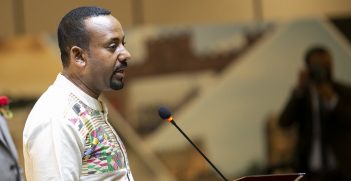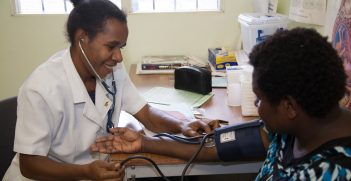Northern Ethiopia Is at Risk of Returning to War—Here’s What Australia Can Do

As a fragile peace deal risks splintering in Tigray, a catastrophic humanitarian crisis could get even worse. As Chair of the UN Peacebuilding Commission and a middle power, here are some small things Australia can do.
Tensions are escalating again in Tigray, as an unsteady peace deal shows signs of splintering. A rival faction within Tigray’s Government (TPLF) has seized control of Adigrat, the second-largest city in Tigray. It has seized offices in Mekele, the regional capital, directly challenging the authority of the Tigray Interim Administration (TIA). The TIA has accused the faction of attempting a coup and has urgently called on the Ethiopian federal government and the international community to intervene. A statement issued by the United States, alongside twenty-four other states, sounded alarm at the escalation of conflict and expressed support for the Cessation of Hostilities (CoHA) agreed to under the Pretoria Agreement, which had agreement brought an end to hostilities to the Tigray War, which occurred from 2020-2022, and has been estimated to be one of the most deadly (and underreported) conflicts of the 21st century, with as many as 700,000 reportedly killed.
Internal political divisions within Tigray’s leadership, combined with rising tensions between Ethiopia and Eritrea, have heightened fears of renewed conflict. In recent weeks, tensions have escalated sharply, with Eritrea reportedly initiating a nationwide military mobilisation and Ethiopia deploying troops towards the Eritrean border. Over the past few years, concerns about the implementation of the Pretoria Agreement, including the lack of humanitarian access and effective delivery in Tigray have undoubtedly contributed to the escalation of tensions.
Tigray is already grappling with one of the world’s worst humanitarian disasters. Over 1 million people are displaced, 2.1 million people are at risk of starvation, and 2.4 million are in need of urgent aid. Infrastructure is in ruins, with health facilities destroyed, leaving millions without basic healthcare.
The dire situation is highlighted by the significant funding shortfalls facing the country, as the Ethiopia humanitarian response plan for 2024 was only 25% funded. Now, with the widespread USAID cuts to humanitarian assistance, that figure is likely to be lower once the United Nations publishes its data. The impacts on the ground currently are beyond horrific, as 2.4 million people in Tigray currently rely on humanitarian grain, with most of that provided by the United States.
The humanitarian crisis Tigray faces largely stems from the horrific war that occurred from 2020-2022, where Ethiopia’s Prime Minister Abiy Ahmed cracked down on the TPLF in response to regional grievances and delayed elections. In June 2024, the New Lines Institute, a nonpartisan think tank in Washington D.C., in collaboration with three independent universities, released a damning report detailing widespread atrocities committed during the war in Tigray. The report presents substantial evidence that Ethiopian forces and their allies carried out genocidal acts against Tigrayans and calls for Ethiopia to be prosecuted at the International Court of Justice (ICJ) for violating the Genocide Convention. The report details horrific accounts of mass murder, rape, forced displacement, physical abuse, torture, and the targeting of civilian infrastructure. Meanwhile, the international community’s overall response to the crisis has been woefully inadequate, characterised by hesitation, muted condemnations, and a humanitarian response that was ineffective and did not meet the needs of the people in Northern Ethiopia.
This year, Australia will take the role of chairing the United Nations Peacebuilding Commission, offering a vital platform to push for accountability and mediation efforts in Ethiopia. Australia must make Tigray a priority on the UN Peacebuilding Commission’s agenda, advocating for sustained international pressure on the Ethiopian government and Eritrea to de-escalate tensions, alongside a sustainable political solution. Additionally, Australia should provide emergency funding to support local NGOs delivering life-saving aid on the ground, aligning with Australia’s New International Development Policy and its commitment to partnering with local organisations.
Australia should also establish a humanitarian visa pathway for Tigrayans fleeing the crisis—similar to the special visa programs created for Ukrainians, Syrians, Afghans, and Myanmar refugees. It is unclear why this has not been done, but it is possible that this crisis has not been considered when developing a humanitarian visa pathway. Furthermore, the expansion of Australia’s Community Sponsorship Program to allow communities to sponsor Tigrayan refugees, as has been done for Syrians and Afghans, must be considered.
While full-scale conflict may not eventuate out of the current tensions, it is important that the international community, including Australia as a middle power, keep this crisis on the agenda, including in the media and international forums. Additionally, the international community must support a strengthened humanitarian response, as millions continue to deal with food insecurity resulting from an unsustainable peace, and now USAID cuts. Given the painful legacies of genocidal violence facing the people of Tigray, alongside the lack of accountability for these crimes, conflict mustn’t return to the region.
Will Devine is the Government Relations & Media Advisor at ACFID, a Board Member at Grassroots Cricket, and an Advisory Council Member at the Australian Institute of International Affairs ACT Branch. He is also studying a Masters of National Security Policy at The Australian National University.
This article is published under a Creative Commons License and may be republished with attribution.





